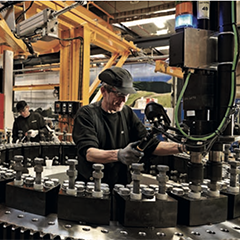Calum Urquhart, Global Business Manager, Energy at Atlas Copco spoke enthusiastically to PES about smart bolting. For sure everyone has been hit by the pandemic but this innovative company, with a strong emphasis on R&D, supporting the customer and sustainability have found new ways of working, which will carry on after the pandemic.
PES: Hi Calum it’s a pleasure to welcome you back to PES Wind. As always, we have many new readers, so it would be great if could you give us a brief history of Atlas Copco.
Calum Urquhart: Sure. Atlas Copco is a global, industrial company based in Stockholm, Sweden, with almost 40,000 employees and customers in more than 180 countries. We are pioneers and technology drivers, and industries all over the world rely on our expertise. Our market-leading compressors, vacuum solutions, generators, pumps, power tools and assembly systems can be found everywhere.
PES: Of course, we know you are a global, well established company, working in many sectors, but which do you feel are the most important and the ones you are currently developing?
CU: The energy sector is an area where have increased our focus significantly in recent years. Historically our focus was on manufacturing industries such as automotive, electronics and aerospace, where we provide assembly tooling, error proofing and quality assurance solutions for quality or safety critical applications on production lines within factories.
As the wind industry has developed in recent years we have also worked with major turbine and equipment OEMs within their facilities providing the same type of solutions. In recent years, as technology has developed in the turbines, we have seen an increased demand for quality control, and error proofing in the field, during the construction, commissioning, and maintenance of wind turbines.
This has led us to increase our strategic focus on the wind energy sector with an increased market presence globally, expanded product portfolio to include all bolting solutions used by the wind sector, and to invest heavily on innovative new solutions to meet the specific demands of the Wind industry.
PES: Could you tell us about the bolting technologies you use in the wind industry?
CU: As mentioned, we have been supplying electrically controlled tools to the wind OEMs in the factories for many years. Where typically you find electrically controlled nutrunners, with integrated transducers and intelligence to secure, the correct process is followed and the results can be logged and/or analysed for quality control purposes. This is commonplace on most factory floors today.
However, in the field it is rather different. Traditionally, tools such as hydraulic torque wrenches, and bolt tensioners have been used for many years, because they were specified in the initial process, despite the fact that the technology is very old. Today electric tools and battery tools are becoming more common as alternatives, due to their improved performance and flexibility, but overall, the tools used in the field are done so based on historic reference, or contractors’ ageing tooling fleets.
In Atlas Copco we took the decision around 7 years ago to provide all the core bolting solutions used by the Wind Industry, as we wanted to become a strategic partner to our customers, and as such we felt it is critical to be able to offer the best product offer regardless of technology so that we could offer the best application advice to our customers, rather than promoting what we have.
This decision of course meant that we needed to invest more heavily in R&D, but that was a strategic decision we took. As a result, today we can offer a full range of both Industrial and Intelligent solutions for all product groups, i.e., hydraulic wrenches, bolt tensioners, electric and battery nutrunners, even manual torque wrenches.
Additionally, with our inhouse engineering team, we have the capability to customise solutions for specific needs as required.





















